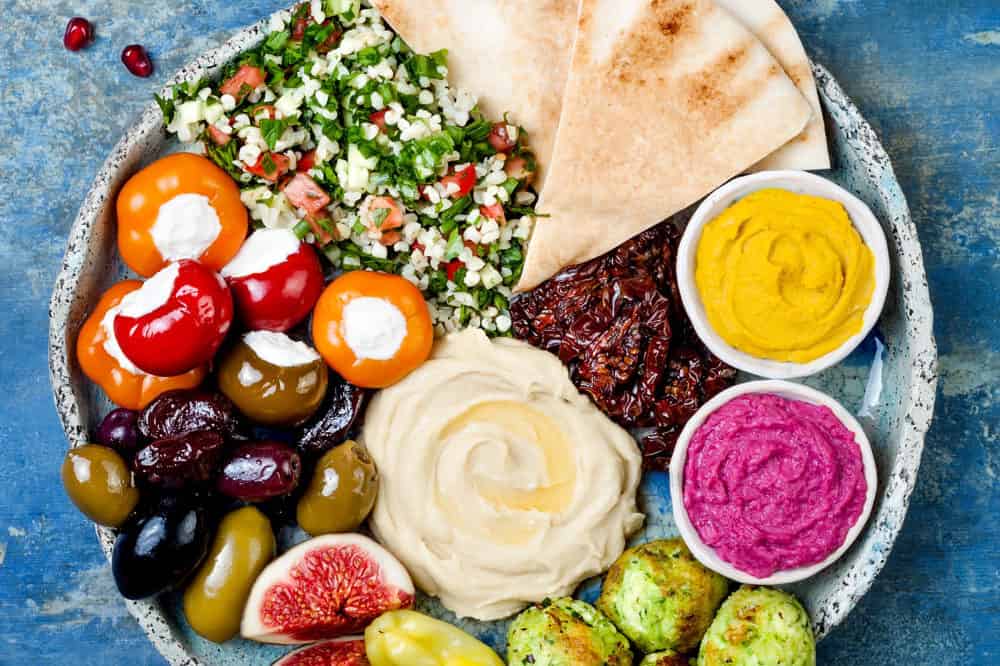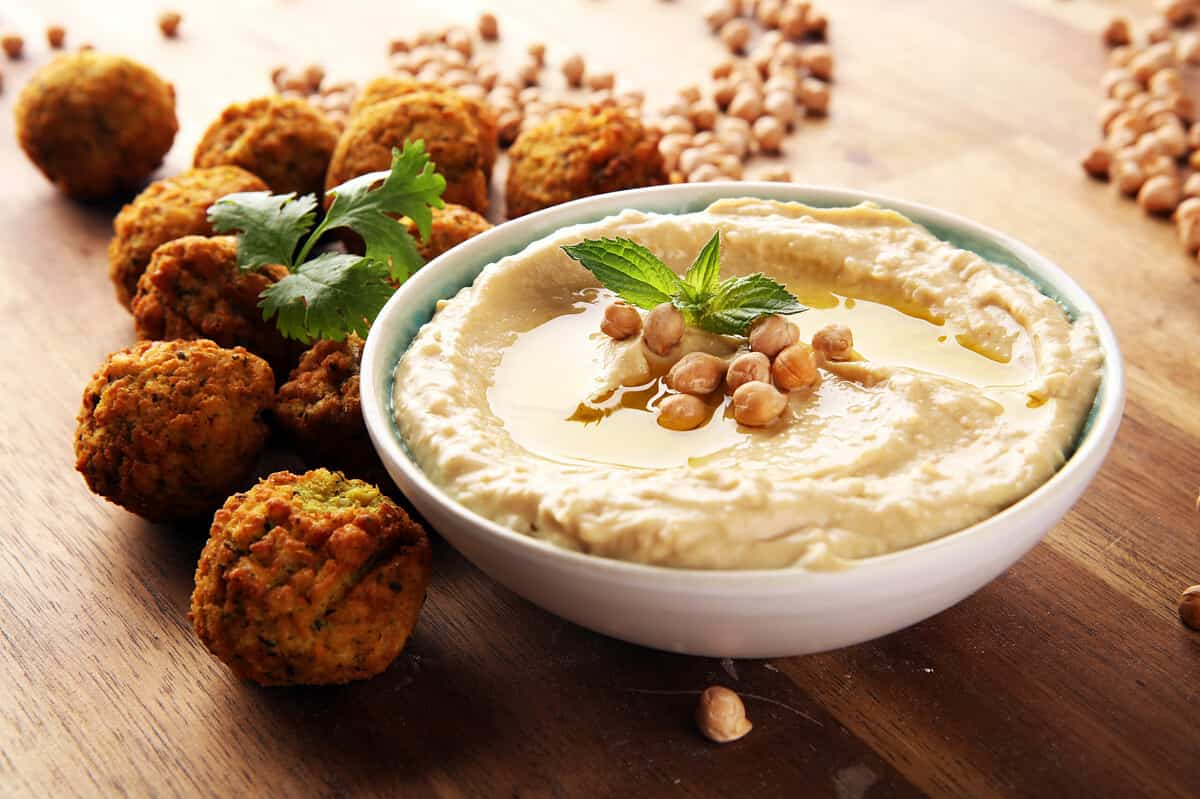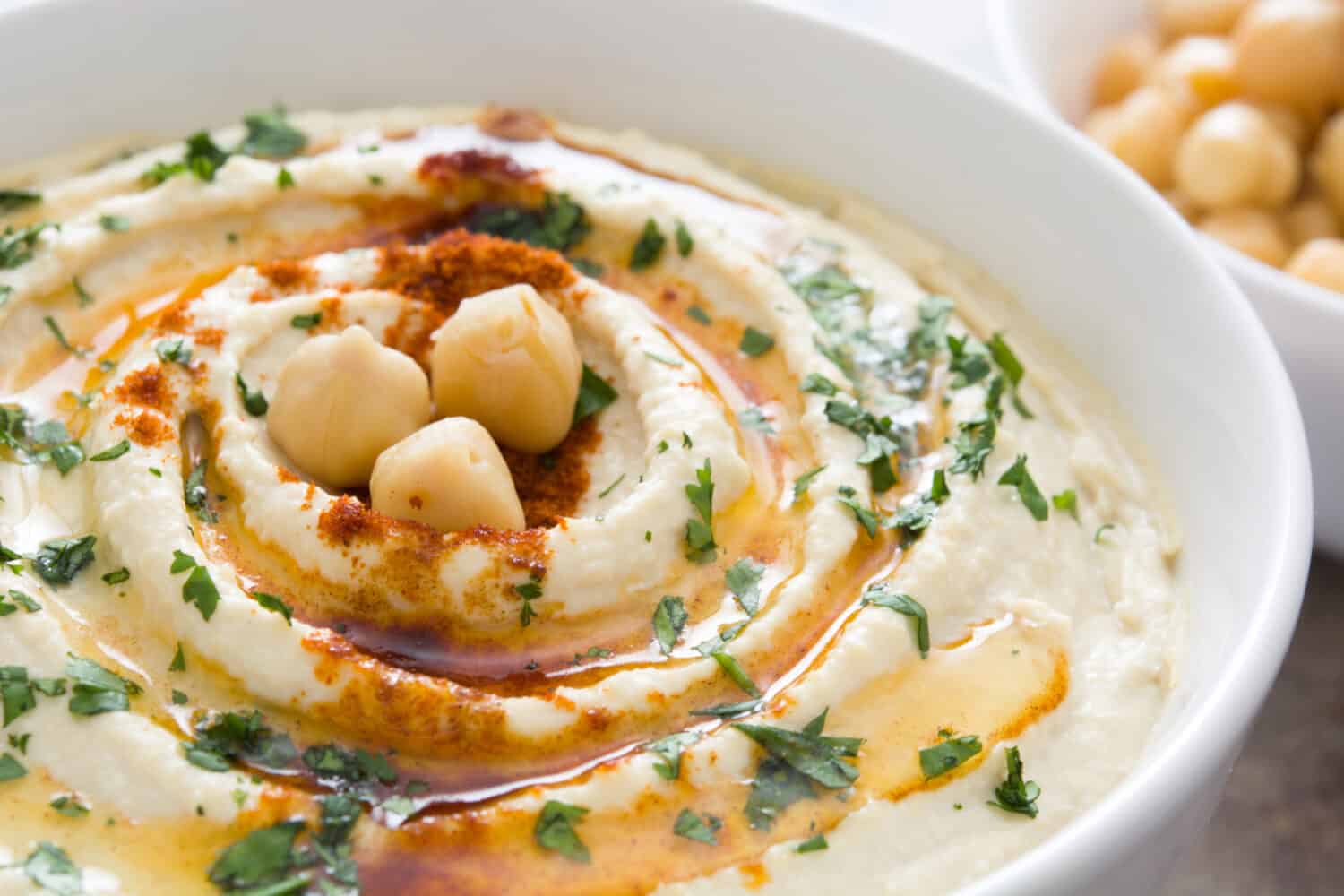Whether you pair it with pita chips or your favorite vegetables, hummus is a popular dip you can find in most grocery stores. No matter where you purchase hummus, it’s usually seen as a healthy snack, but considering its popularity, you might wonder if hummus is healthy. We’re going to tackle whether hummus is actually healthy or whether it’s a snack you should avoid. Let’s first dive into what hummus is made of.

Hummus has presumably been around for thousands of years and originated in the Middle East.
©zarzamora/Shutterstock.com
What Is Hummus?
Hummus is a dip or spread made from chickpeas, olive oil, and seasonings. In the grocery store, you'll find numerous brands that sell their own version of hummus in a variety of flavors. Some of the most common varieties are classic hummus, roasted garlic hummus, and roasted red pepper hummus. You'll also notice hummus is often served in Greek and Middle Eastern restaurants.
Hummus certainly isn’t a new creation, but the first written record of this tasty dip came from Egypt in the 13th century. The word hummus actually means “chickpea.” There is some debate about when hummus first originated, but most historians agree hummus likely originated in the Middle East thousands of years ago.
Despite the extensive history surrounding the origins of hummus, it didn’t become popular in the U.S. until the 1980s. In 1986, Zohar Norman started his own brand of hummus called Sabra. Nowadays, Sabra is the most well-known brand in most places in the U.S.
Whether homemade or store-bought, hummus is often considered a healthy dip or spread. But is hummus actually healthy? Let’s take a closer look at the ingredients in hummus.
Is Hummus Actually Healthy?
While hummus comes in numerous varieties and flavors, most of the time, hummus is actually healthy. This dip is made by pureeing cooked chickpeas, tahini, olive oil, salt, and pepper. These ingredients make up the classic hummus recipe, but there are many varieties from roasted garlic hummus to red pepper hummus.
Interestingly enough, hummus is no longer just a savory dip. If you browse the selections of hummus at your local grocery store, you’ll also find dessert hummus. Dessert hummus is still made of chickpeas, but it also has cocoa powder and sweeteners. Unlike your standard hummus, dessert hummus is a relatively new creation.
No matter what kind of hummus you choose, hummus is a healthy spread that pairs perfectly with pita chips or vegetables like carrots or cucumbers. Some versions of hummus may be healthier than others, especially when you consider the added sugar, preservatives, and other ingredients in certain varieties. But even with some added ingredients, what all hummus has in common is the benefits you get from the chickpeas.
Benefits of Eating Hummus
The most simple hummus recipes include cooked chickpeas, tahini, olive oil, salt, and pepper. While you do need to look out for added preservatives and other ingredients, there’s nothing unhealthy about most versions of hummus.
The main ingredient in hummus is chickpeas, also known as garbanzo beans. One of the other main ingredients is tahini, which is simply ground sesame seeds. Some other common ingredients include lemon juice, garlic, and other seasonings.
What makes hummus healthy is the many vitamins and minerals in this delicious spread. About one tablespoon of hummus contains:
- 45 calories
- 2.25 grams of carbs
- 7 mg of calcium
- 11.2 mg of magnesium
- 46.8 mg of potassium
- 7.2 µg of folate
While most servings of hummus will be closer to 2 tablespoons or more, this gives you an idea of just how nutrient-filled hummus is. Here are some other benefits of eating hummus:
Filled with Nutrients
The biggest benefit of hummus is that it’s nutrient-rich. It has high amounts of fiber, magnesium, and potassium, but it’s also relatively low in calories and carbs. While the amount of protein is not necessarily enough for a high-protein diet, it’s a good way to add some extra protein to your meals, especially if you eat a plant-based diet.
Good for Digestion
Eating hummus is a great way to support a healthy digestive system. This is mainly due to the amount of fiber in hummus. About two tablespoons of hummus provides you with 6% of your daily fiber intake, which can help keep your digestive system healthy and promote the growth of healthy bacteria in your gut.
Helps with Appetite Control
For those who are trying to avoid unhealthy snacks, the nutritional content of hummus can help you stay full longer and help with appetite control. While snacks with empty calories and little nutritional content, such as potato chips, can cause overeating, hummus has protein, fiber, and other nutrients that help keep you satisfied and avoid unhealthy snacking.
Downsides of Eating Hummus
Hummus is, in fact, a healthy snack, especially when compared to some of the other snacks and dips out there. However, there are some downsides to eating hummus.
The main downside to eating hummus is the fact that it can be high in sodium. Sodium is a necessary nutrient, but when consumed in high quantities, it can lead to health problems such as high blood pressure.
Additionally, pre-packaged hummus that you might find in the grocery store often has added ingredients such as preservatives. Store-bought hummus also might have nuts and other ingredients that can impact people with food allergies.
For the healthiest version of hummus, the best thing you can do is make the hummus yourself. It’s relatively easy to make with a food processor, and making it at home allows you to control what goes in it.

Hummus is a delicious, healthy spread that's easy to make at home.
©beats1/Shutterstock.com
How to Make Your Own Hummus
Interested in making hummus yourself? Hummus is a healthy, nutrient-rich snack, especially when you pair it with vegetables or include it in a protein bowl. The healthiest way to eat hummus is to make it yourself at home. To make your own hummus, you’ll need:
- Cooked chickpeas
- Olive oil
- Lemon juice
- Salt and pepper
- A food processor or blender
You may even find that once you make your own hummus, you won’t want to buy it in the store again. It’s healthier, cheaper, and tastes a lot better than store-bought hummus! If you don’t have a food processor, you can make hummus with a potato masher or even try mashing your chickpeas by hand. However, a food processor will guarantee you get the absolute smoothest texture.
Here are the steps to making your own hummus:
- Add your ingredients to the food processor
- Process until the consistency of the hummus is smooth
- If it needs more time, scrape the sides and process again
- Add the hummus to an air-tight container and chill until ready to serve
It’s that easy! If you want to try to make your own hummus, check out this recipe for red pepper hummus.
Ways to Serve Hummus
Now that you’ve made your own hummus, what should you do with it? There are numerous ways to serve hummus, depending on your preferences. How healthy the hummus is will also depend on how you serve it.
Here are some healthy ways to serve the batch of hummus you made at home:
- Serve it as a dip with a side of vegetables
- Use it as a spread on a roasted vegetable sandwich
- Serve it with pita bread
- Serve it as a side for a Greek salad
Another good thing about making your own hummus is you can customize it in any way you choose. There are a variety of hummus recipes, from red pepper hummus to garlic roasted hummus, and there are no limits to the ingredients you can add. If you’re feeling brave, you can even try your hand at a dessert hummus recipe.
Next time you’re looking for something salty but want to avoid grabbing a bag of chips, try homemade hummus and vegetables instead!
Recipe Card
If you're looking for a tasty hummus recipe, look no further. Try one of our favorite recipes out:
Print
Roasted Red Pepper Hummus Dip
- Total Time: 10 minutes
Ingredients
- 1 can (15 oz) chickpeas, drained and rinsed
- 1/3 cup tahini
- 1/4 cup extra-virgin olive oil, plus more for serving
- 1/2 cup roasted red peppers (from a jar or homemade), drained
- 2 cloves garlic, minced
- Juice of 1 lemon
- 1 teaspoon ground cumin
- Salt and pepper to taste
- Optional: Pinch of cayenne pepper for some heat
- Fresh parsley for garnish
Instructions
Combine Ingredients:
- Combine chickpeas, tahini, olive oil, roasted red peppers, minced garlic, lemon juice, cumin, salt, pepper, and cayenne pepper in a food processor.
Blend until Smooth:
- Blend the ingredients until the mixture is smooth and creamy. If needed, add a bit of water to achieve your desired consistency.
Taste and Adjust:
- Taste the hummus and adjust the seasonings to your liking. If desired, add more lemon juice, salt, or cayenne pepper.
Serve:
- Transfer the hummus to a serving bowl. Create a swirl on the surface with the back of a spoon and drizzle with a bit of olive oil.
Garnish:
- Garnish with fresh parsley for a burst of color and added freshness.
Serve with Dippers:
- Serve the roasted red pepper hummus with dippers such as pita bread, tortilla chips, carrot sticks, or cucumber slices.
The image featured at the top of this post is ©etorres/Shutterstock.com

